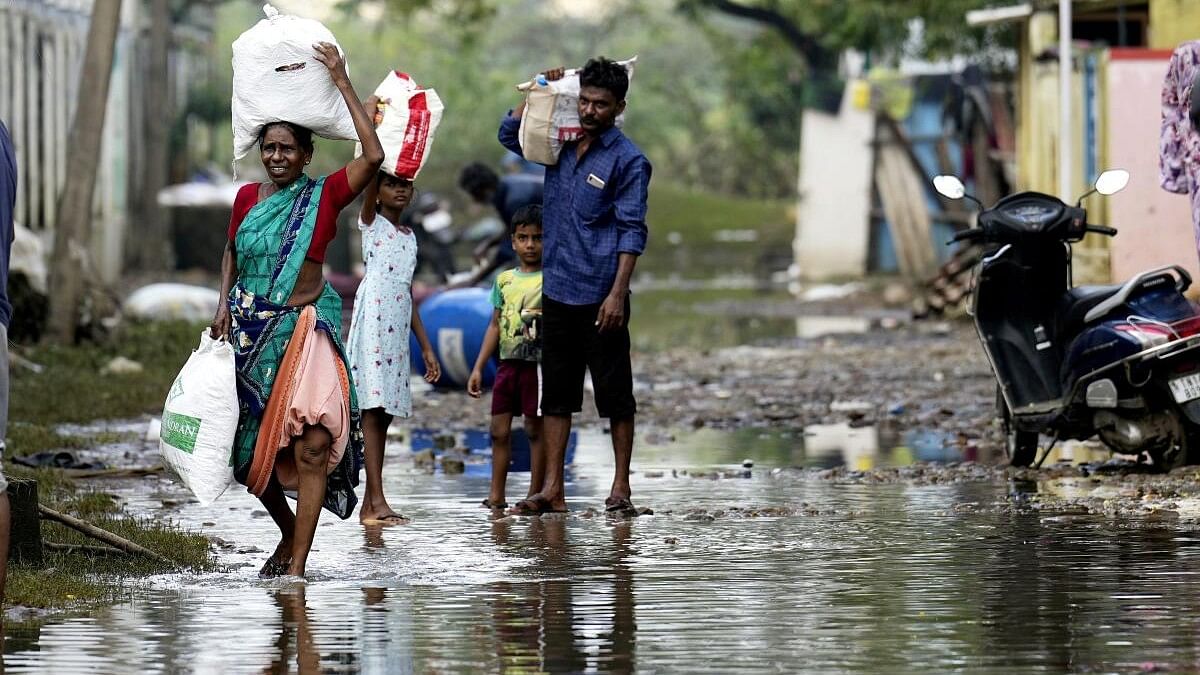
Locals retrieve their belongings at Kamatchi Amman Nagar area inundated with floodwater after heavy rainfall in the aftermath of Cyclone Michaung, in Chennai.
Credit: PTI
The recent Chennai floods brought back memories of similar floods in 2015, where more than 400 lives were lost. This time, the casualties were significantly reduced, which shows the administration has learnt from its past incident.
Yet, many places in Chennai continue to be underwater, and power blackouts and the non-availability of essential items for many days added misery to the lives of millions. As expected, many questioned Chennai's and its suburbs' preparedness and urban planning. At the same time, there are claims that the stormwater drainage project running for kilometres saved the city from threatening inundation. Some in the administration have pleaded helplessness in the event of seawater pushing back into these stormwater drainages and cite this for poor flood management.
Chennai is a symbol and symptom of the disasters that Indian cities are subject to, and the preparedness of the administration to tackle these disasters. Though an office of Disaster Resilient Officers (DRO) was created in Indian cities as per the national disaster management plans, there has been limited success, visibility, and awareness about the office in most cases.
The issue starts with the authority, resources, and recognition of the city governments in India. As in other city matters, the multiplicity of the agencies and lack of coordination among the departments of both the state and local governments warrant the state government to step in as the advisories come from the MET department. Once the calamity is over, the resilient part and preparation for future calamities are set aside for another time.
Thanks to smart city projects, most cities are coming up with command-and-control centres. The Government of India uses data and special attributes for many of its project planning and execution to the extent of mapping the changes in land use and commercial buildups around them. PM Gati Shakthi is such an initiative. The question here is whether we have generated sufficient data points at the city level regarding the risks and vulnerabilities related to land use and the damages and pressure points in the fragile environment.
In Chennai and many other cities, the reason for the flooding is often cited as the encroachments to its wetlands and the massive construction in these ecologically important but sensitive sites. The old canal systems, integral to Chennai's landscape, have yielded to urban development, with many of these waterways now concealed by multi-storied apartments. Additionally, their safety outlets, crucial for flood management, may have been completely closed and disconnected from the rest of the network. The shrinkage of ponds, reservoirs, and green spaces in urban areas often goes unnoticed until a calamity strikes, at which point the contestation becomes more pronounced.
Cities are the growth engines contributing the most to employment generation. Cities compete to attract talent and investments. A city's resilience is an important factor in ensuring its sustainability, the well-being of its citizens, and the security of investments made. To enhance resilience, cities should invest in generating data and maps featuring various risk factors and vulnerabilities involved in land use patterns. It could cover the degree of disaster-proneness, soil conditions, the water canals, wetlands, depth of the underground water, proximity to the larger water bodies, closeness to the reservoirs, and their canals, the road and transport network on these maps help to understand the threat to these networks at the time of water logging. Such an initiative will help disaster management authorities prepare plans while the public makes informed decisions about land transactions and constructions in vulnerable areas. Such models are available, for example at VMAP and the United States’ FEMA.
There exists a market failure in the accessibility and provision of information regarding disaster resilience. Although introducing such information may initially disrupt the real estate market and pose social risks, cities stand to gain substantial long-term benefits by prioritising data that ensures the protection of their citizens’ health and wealth. Informed decision-making improves, fostering a more transparent and prepared city-citizen relationship.
The decisions are more informed, and the social contract between the city and the citizens improves significantly based on transparency and preparedness. The current AI models offer an opportunity to analyse vulnerabilities associated with land use patterns, presenting a positive externality of available data and information.
The framework outlined in COP28 for Global Stocktaking provides a blueprint for assessing and addressing global challenges. India must develop a city stocktake, focusing on data generation and disaster mitigation strategies, aligning with the global commitment to resilience and preparedness.
(D Dhanuraj is Chairman, and Nissy Solomon is Senior Research Associate at, the Centre for Public Policy Research, Kochi.)
Disclaimer: The views expressed above are the author's own. They do not necessarily reflect the views of DH.